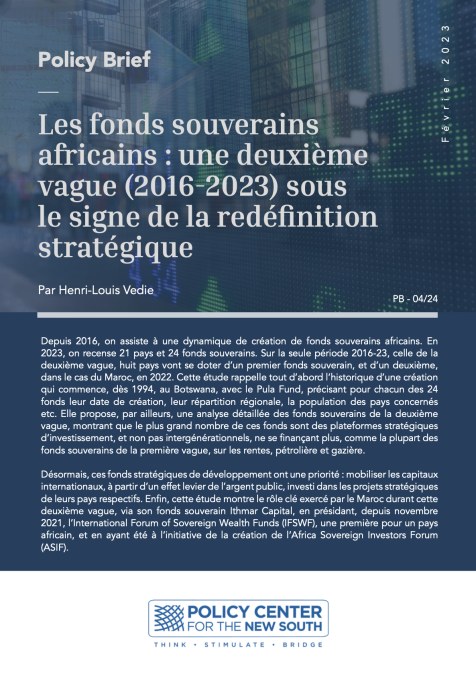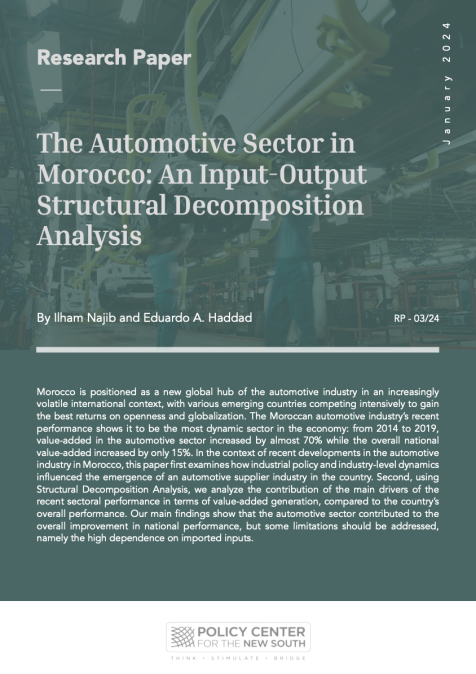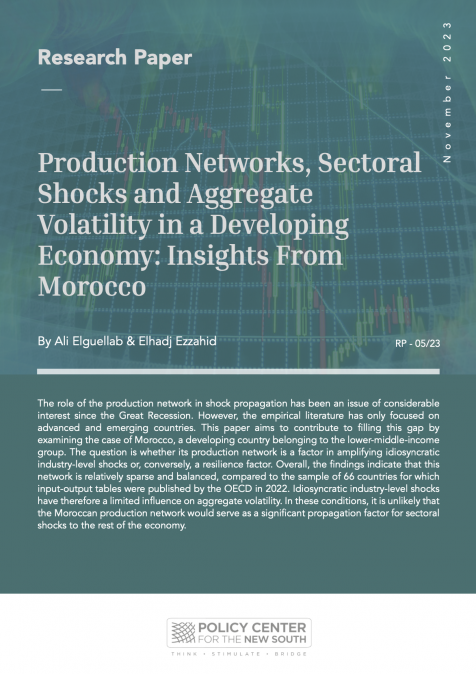RELATED CONTENT
-
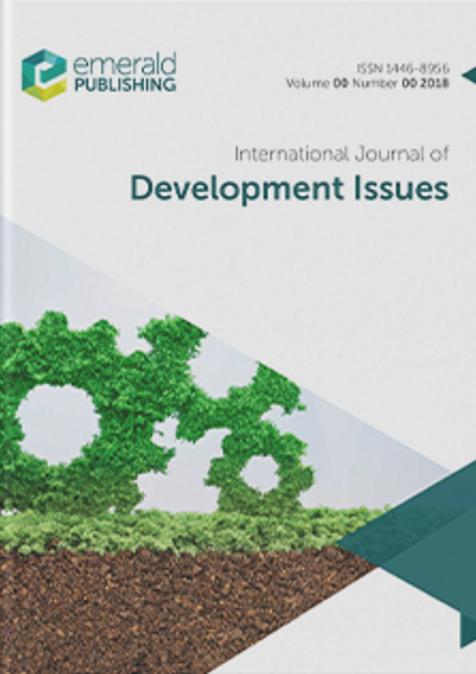 AuthorsZakaria ElouaourtiSeptember 13, 2024This Paper was originally published on emerald.com Purpose This paper examines the dynamics of structural transformation in Morocco since 1970 by analyzing input-output tables expressed in terms of employment and output levels across 24 sectors. Design/methodology/approach This study employs a twofold methodological approach. Firstly, it examines the evolution of sectoral employment shares over time using World Bank data. Secondly, it utilizes Input-Output analysis to examine ...
AuthorsZakaria ElouaourtiSeptember 13, 2024This Paper was originally published on emerald.com Purpose This paper examines the dynamics of structural transformation in Morocco since 1970 by analyzing input-output tables expressed in terms of employment and output levels across 24 sectors. Design/methodology/approach This study employs a twofold methodological approach. Firstly, it examines the evolution of sectoral employment shares over time using World Bank data. Secondly, it utilizes Input-Output analysis to examine ... -
Helmut Sorge and Hans Peter LankesAugust 23, 2024Delve into the critical topic of fostering Africa's economic transformation through innovative financing. Hans Peter Lankes shares his expertise on what innovative financing entails and t ...
-
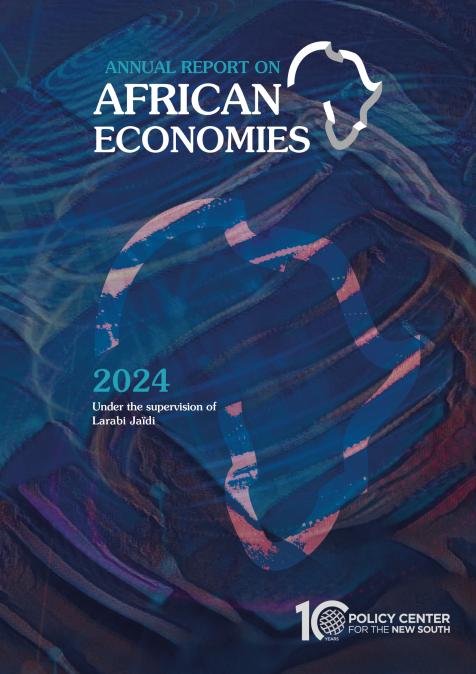 AuthorsUnder the supervision ofJuly 12, 2024Bientôt disponible en vente sur livremoi. The 2024 Annual Report on the African Economy is dedicated to monetary and financial issues on the Continent. There are three reasons for this choice. African economies are exposed to macro-financial instabilities partly generated by global monetary and financial turbulence. The Continent’s currencies and financial systems are engaged in very different dynamics, where routine methods and daring, if not risky, practices coexist. The q ...
AuthorsUnder the supervision ofJuly 12, 2024Bientôt disponible en vente sur livremoi. The 2024 Annual Report on the African Economy is dedicated to monetary and financial issues on the Continent. There are three reasons for this choice. African economies are exposed to macro-financial instabilities partly generated by global monetary and financial turbulence. The Continent’s currencies and financial systems are engaged in very different dynamics, where routine methods and daring, if not risky, practices coexist. The q ... -
AuthorsFebruary 8, 2024Depuis 2016, on assiste à une dynamique de création de fonds souverains africains. En 2023, on recense 21 pays et 24 fonds souverains. Sur la seule période 2016-23, celle de la deuxième vague, huit pays vont se doter d’un premier fonds souverain, et d’un deuxième, dans le cas du Maroc, en 2022. Cette étude rappelle tout d’abord l’historique d’une création qui commence, dès 1994, au Botswana, avec le Pula Fund, précisant pour chacun des 24 fonds leur date de création, leur ...
-
AuthorsIlham NajibJanuary 29, 2024Morocco is positioned as a new global hub of the automotive industry in an increasingly volatile international context, with various emerging countries competing intensively to gain the best returns on openness and globalization. The Moroccan automotive industry’s recent performance shows it to be the most dynamic sector in the economy: from 2014 to 2019, value-added in the automotive sector increased by almost 70% while the overall national value-added increased by only 15%. In the ...
-
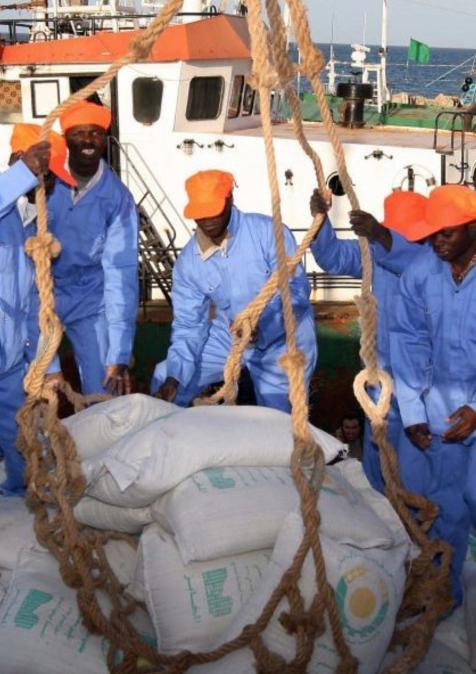 AuthorsJanuary 2, 2024This paper was originally published on The South African Institute of International Affairs (SAIIA) In order for Africa to raise living standards, create employment for youth and diversify exports, it must industrialise. Until recently, sub-Saharan African (SSA) countries made limited progress in manufacturing value addition and employment, mirroring the de-industrialisation trend seen in many developing countries. To propel industrialisation, SSA countries should adopt flexible st ...
AuthorsJanuary 2, 2024This paper was originally published on The South African Institute of International Affairs (SAIIA) In order for Africa to raise living standards, create employment for youth and diversify exports, it must industrialise. Until recently, sub-Saharan African (SSA) countries made limited progress in manufacturing value addition and employment, mirroring the de-industrialisation trend seen in many developing countries. To propel industrialisation, SSA countries should adopt flexible st ... -
December 28, 2023In this episode, we interviewed Mr. Arkebe Oqubay Metiku, British Academy Global Professor, SOAS University of London around Africa's industrial policies and their impact on growth. We discussed key elements such as innovation, regional collaboration, sustainability, and intellectual pr...
-
November 30, 2023In this episode, we dive into the pressing necessity for climate initiatives in Africa. Despite its minimal global emissions, Africa grapples with severe climate challenges and a substantial funding shortfall. Yet, as obstacles persist, including the disconnect between investor expectat...
-
Helmut Sorge & Thierry WarinNovember 03, 2023As the world enters the era of the fourth industrial revolution characterized by advances in artificial intelligence, robotics, the Internet of Things, and automation, the preparedness of ...
-
AuthorsAli ElguellabElhadj EzzahidNovember 1, 2023The role of the production network in shock propagation has been an issue of considerable interest since the Great Recession. However, the empirical literature has only focused on advanced and emerging countries. This paper aims to contribute to filling this gap by examining the case of Morocco, a developing country belonging to the lower-middle-income group. The question is whether its production network is a factor in amplifying idiosyncratic industry-level shocks or, conversely, ...


